One of Europe’s most hotly contested rivalries sees its newest chapter written this weekend, with Slavia Prague playing hosts to city foes Sparta Prague on Sunday.
These clubs are the two most successful in their nation’s history, with a staggering combined total of 54 league titles between them.
Sparta Prague are currently under the tutelage of 46-year-old Brian Priske, formerly of Danish Superliga side Midtjylland, where he led his team to the 2019/20 championship crown and, most recently before moving to the Czech Republic last summer, Belgian Pro League side Royal Antwerp who he led to a fourth-place finish in 2021/22. They are the most successful side in their nation’s history, with 34 titles to their name.
This includes last season’s title. However, Slavia Prague have enjoyed more success over the last decade, winning four to Sparta’s two in that time. Their 20 league titles place them second in Czechia’s history books for championship glory.
Jindřich Trpišovský has been in charge at Slavia since 2017, winning three Czech first-division crowns in that time. The 47-year-old has spearheaded a successful era in the club’s history, stamping his tactical identity on the club and edging them closer in the all-time ladder to arch nemesis Sparta.
This season, there’s very little to separate the two Czech giants with eight games played; both sit on 22 points, having won seven and drawn one. Both enter Sunday’s Prague Derby clash undefeated in the league.
The stage is set for an epic encounter that could see a significant psychological advantage earned by the winning side of this battle between the country’s two main footballing pillars.
Our tactical analysis will examine key elements of the two UEFA Europa League competitors’ respective strategies and tactics as we preview Sunday’s Czech First Division game. Our analysis will highlight how both teams approach the game in and out of possession, establishing where we determine this fixture can be won and lost.
Slavia Prague in possession
Jindřich Trpišovský’s side have kept the highest average possession percentage (63.1%) in Czechia’s top flight this season. Despite this, Slavia are prone to playing the ball long and going direct much more than their city rivals, Sparta.
Slavia are very comfortable playing in transition, relying on their attackers’ runs and quick-thinking progressive passers to generate awkward situations for the opponent’s defence to deal with as they scramble to recover and settle in their defensive shape.
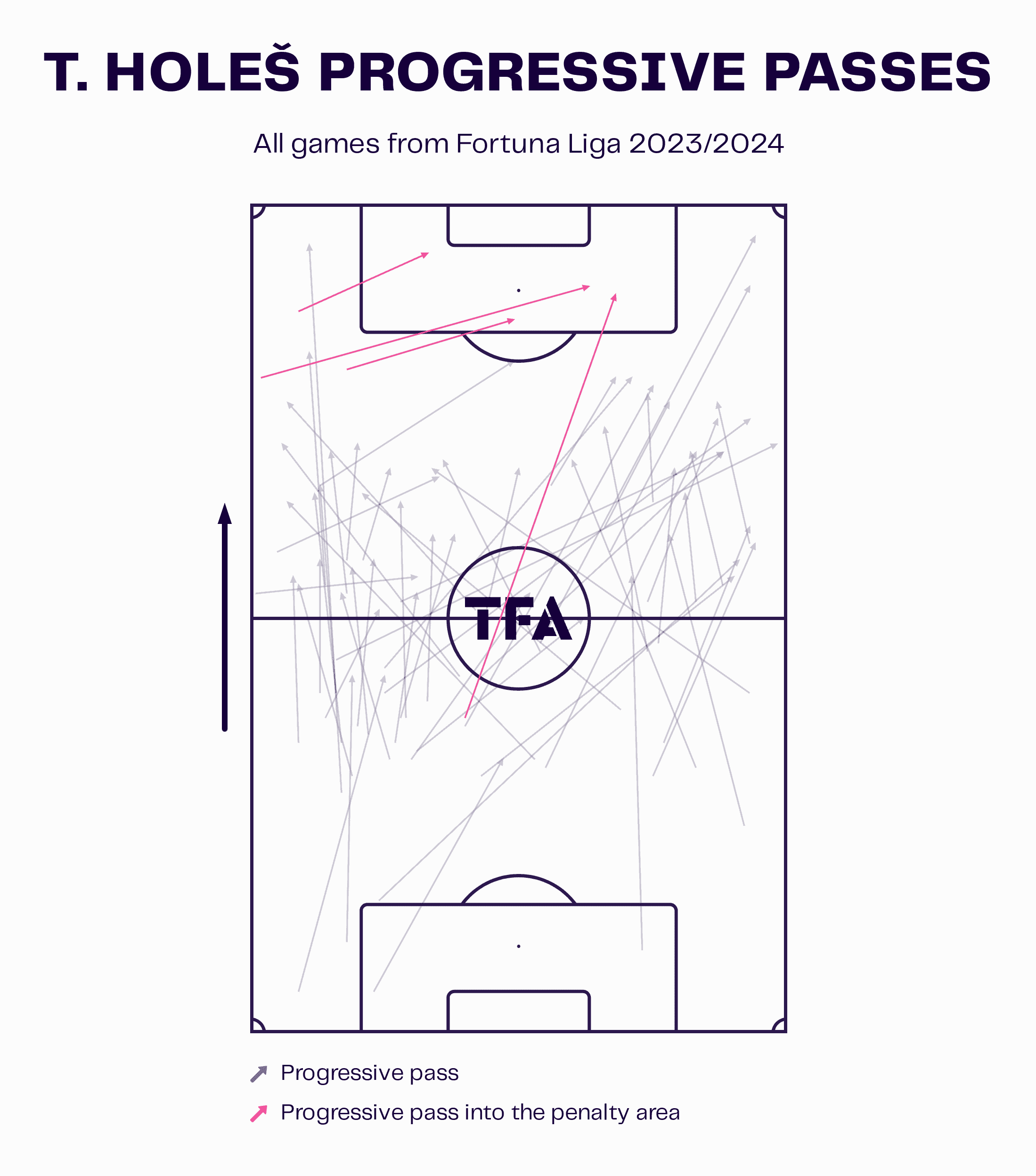
Tomáš Holeš has acted as captain on occasion this season, with Jan Boril not being available for several games at the start of the 2023/24 campaign. Holeš has typically played in the centre of Slavia’s back three and above; we see how he’s sprayed the ball around the pitch from that position, launching his side into the final third with great regularity, aiming to quickly generate goalscoring opportunities by playing his side in behind the opposition’s backline.
Of all players from both sides in question, Holeš has by far made the most long passes this term. He’s totalled 11.58 per 90. This is an unmistakable weapon in Slavia’s game that Trpišovský will look to use.
Indeed, the per 90 numbers must be taken with a grain of salt as some clearances will have crept in there among other questionable pure ‘long passes’. However, from watching their play, it’s clear that Slavia are not afraid to intentionally use Holeš’s long passing to target forwards to contest aerial duels and, hopefully, win the resulting second ball or play an attacker in behind.
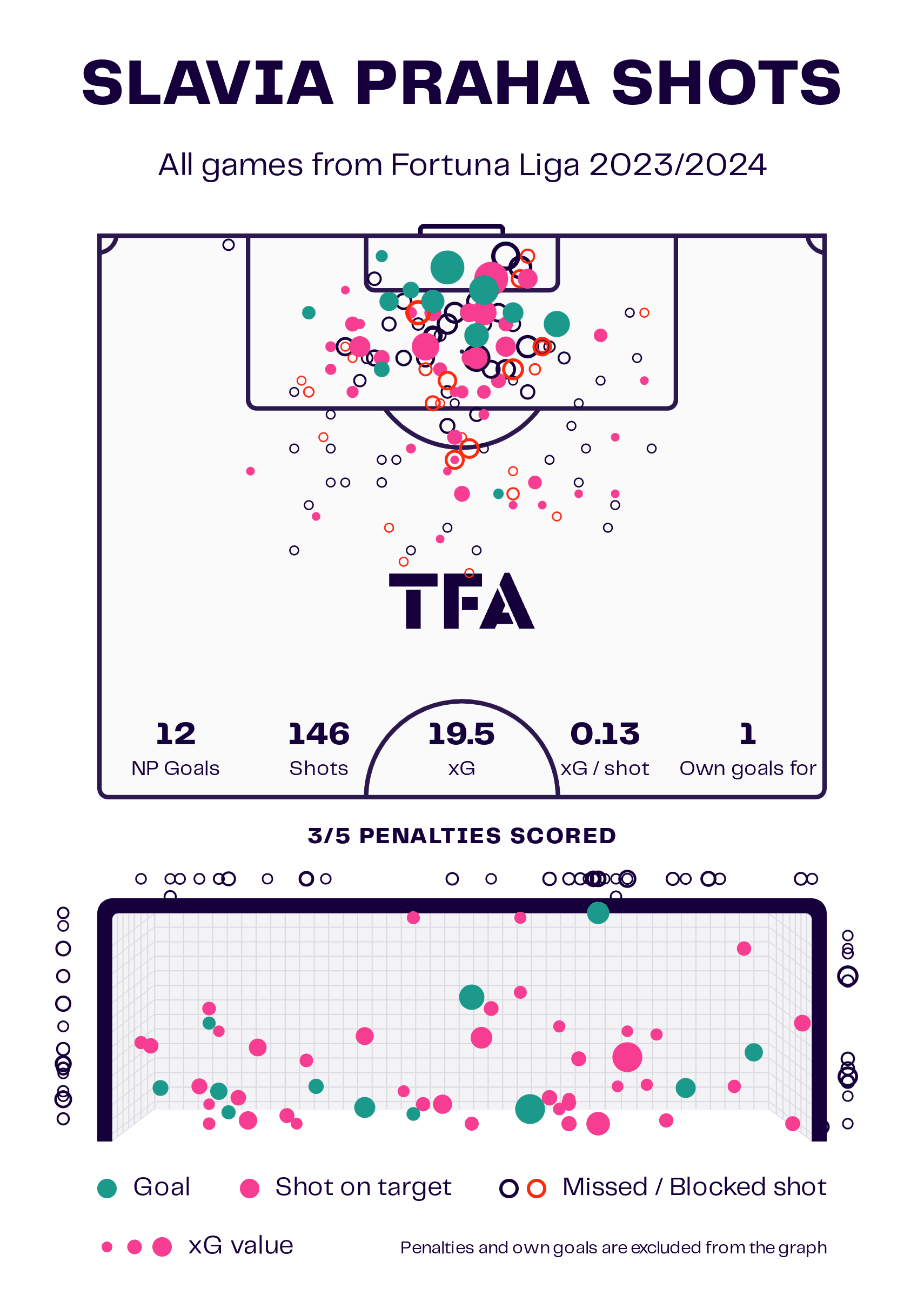
Slavia have generated the highest xG numbers in Czechia’s top-flight for 2023/24. However, from their 19.5 non-penalty xG, they’ve converted just 12 goals — unconvincing numbers that point to a lack of conviction in their finishing this term.
This is partly down to luck, and you would expect to see some variance over time, so this will likely end up balancing out in the long run. However, these are concerning numbers to be carrying into a big derby clash.
On the plus side, though, Slavia have been creating heaps of chances and frequently putting the ball in the right areas, which is encouraging. They must start consistently converting these chances to leap above their city rivals on the league table, though, as they will be well aware.
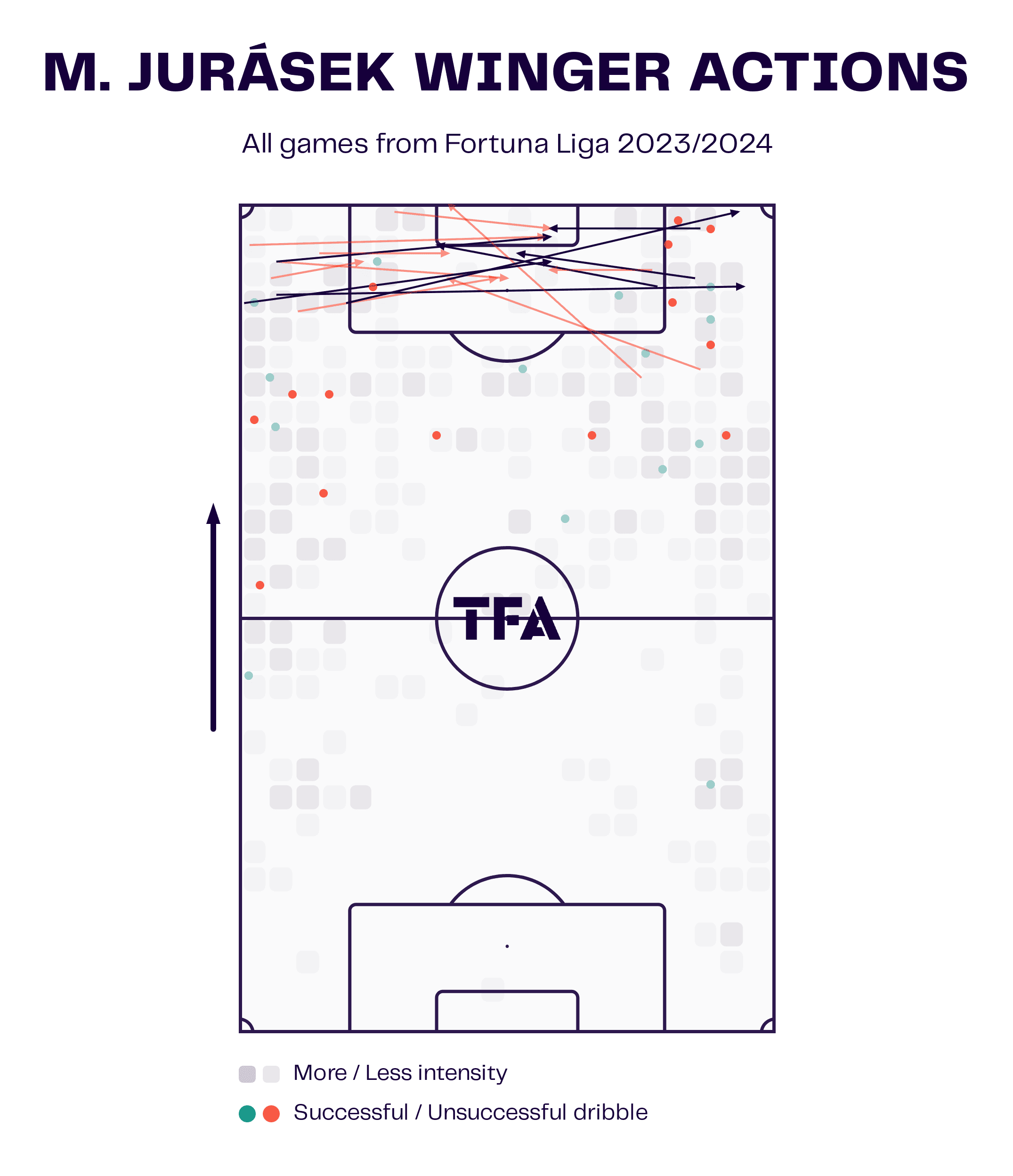
Matěj Jurásek is one player we can expect to contribute significantly to chance creation for Slavia on Sunday. He’s been a key dribbler for Trpišovský’s side this season, most frequently playing off the right but also occasionally featuring on the left.
The darker squares on the above viz highlight his most heavily occupied areas. This clearly displays he’s a winger who likes to cut inside and play in the half-spaces.
Jurásek loves to run at defenders and will pose a significant threat in the final third during Sunday’s Prague Derby.
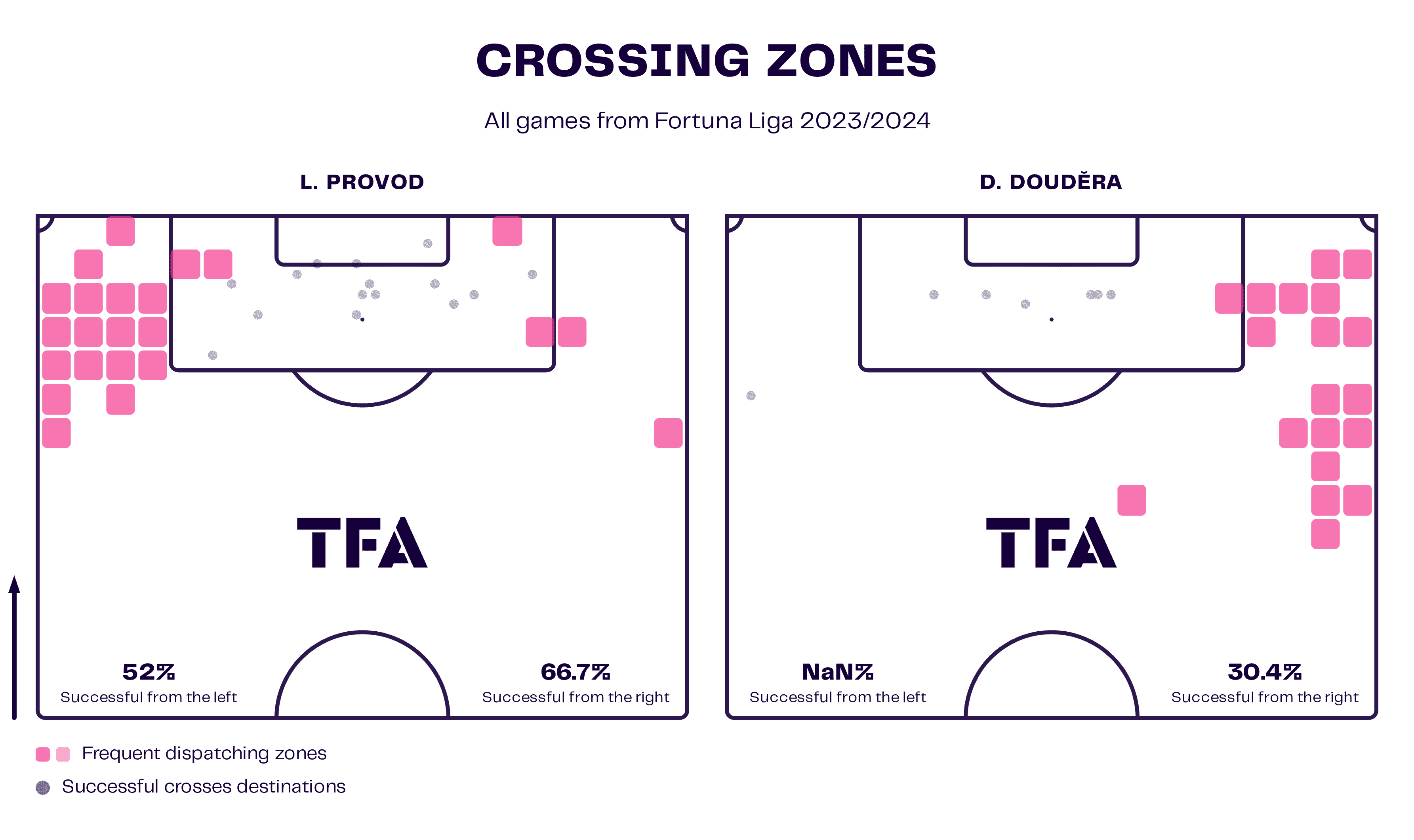
While Jurásek cuts inside and occupies central areas, the width on the right will be provided by Slavia’s right wing-back in the 3-4-3 system they typically utilise. David Douděra is a decent option on this side who frequently creates chances when he features for Slavia via his crossing.
Douděra is comfortable crossing early, from deeper positions, as the above crossing zone figure indicates. On the other hand, his left-sided teammate, Lukas Provod, is also a high-volume crosser but tends to play his balls into the box from slightly more advanced areas. However, like Douděra, he typically crosses from wide, occupying the wide channel as the left-winger plays narrower when Slavia enter the final third.
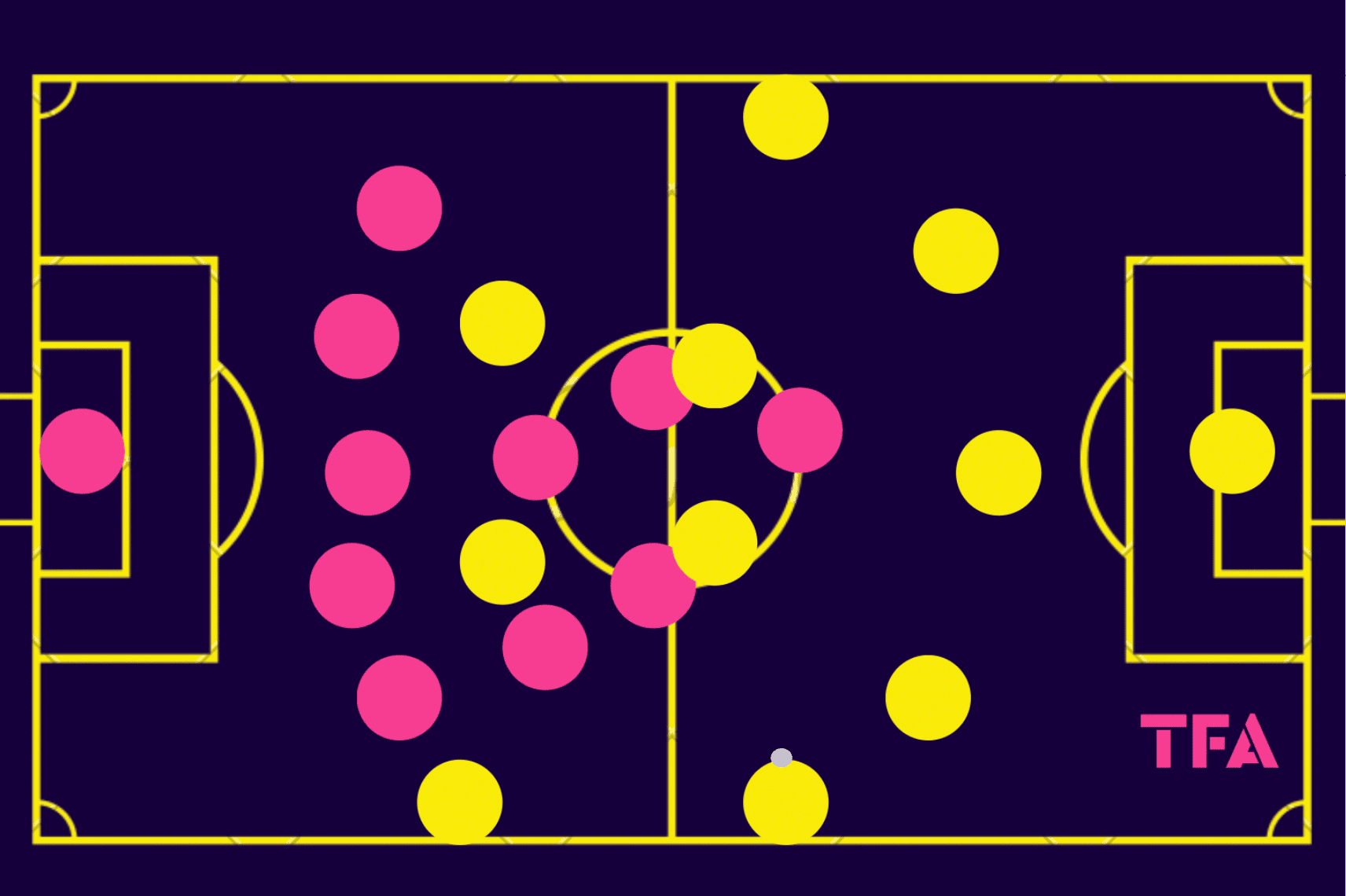
Figure 5 shows an example of Slavia’s (yellow) shape when progressing from their half into the opposition’s. Their wing-backs always hug the sidelines, regardless of the positioning of the ball, their teammates or the opposition.
The wingers will adjust their positioning and come very narrow, as mentioned. This happens earlier for the winger on the opposite side of the ball, as figure 5 indicates.
The ball-far winger becomes a second striker very early in the possession phase, helping the actual centre-forward occupy the opposition’s centre-backs. The ball-near winger will also move narrow, but not immediately. This will occur as Slavia enter the opposition’s half.
Again, Slavia’s directness is a critical factor in their game. While their central midfielders will often be occupied and marked out of the game, as was the case here, their centre-backs will be comfortable playing the ball over the midfield and going directly into the forward line, where Slavia can generate overloads quickly, especially as the wing-backs drive forward in support on the outside — this is something Sparta need to be prepared for on Sunday.
Sparta Prague in possession
Sparta, meanwhile, have kept the second-most possession in their league this term (58.4%). Despite keeping less of the ball than Slavia, overall, they tend to be less direct with it. While Slavia have played the fifth-most long balls (48.6 per 90) in the Czech top-flight this season, Sparta have played the fewest of all teams in the division (35.03 per 90).
This represents a marked difference between the two sides and how they approach their possession play. Sparta tend to be more methodical and measured in how they build their attacks, carefully passing from player to player to carve their way through the opponent’s defensive block intricately.
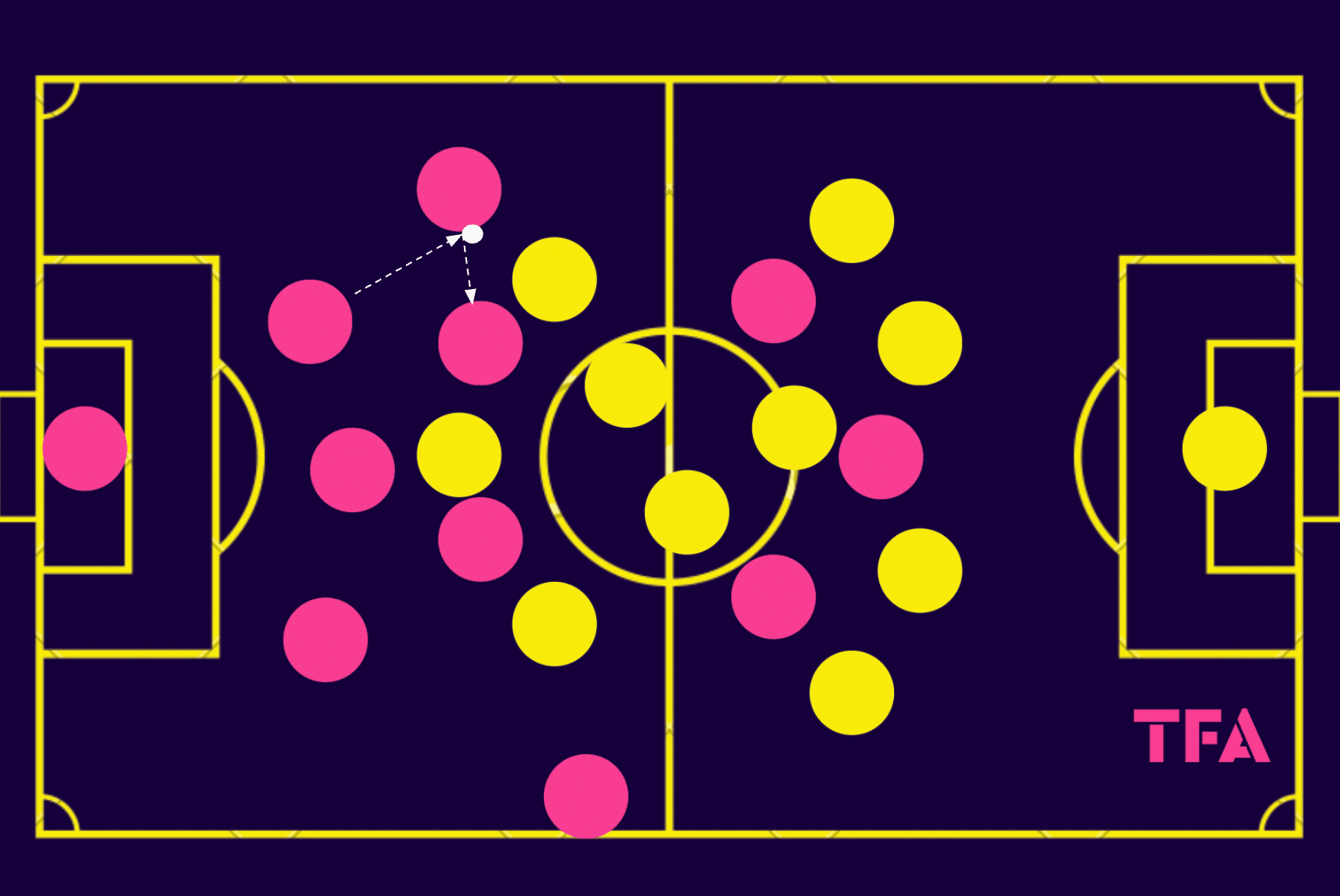
Figure 6 shows how Sparta (pink) line up in a typical possession phase. Firstly, their wing-backs don’t necessarily hug the sidelines in the same way Slavia’s do. As in this example, one might hug the sideline while the other comes narrower.
The left wing-back came and offered himself as a short passing option for the left centre-back, creating a triangle with the left central midfielder, which they use to get the ball into central midfield. However, the opposition are heavily congesting this central area and will ultimately force Sparta backwards.
They’re happy to be patient and work away at these kinds of plays until the right opportunity to break through the opposition’s defensive shape presents itself.
The wide attackers often prove crucial in Sparta’s ball progression via their off-the-ball movement and ability to provide options for the centre-backs and midfielders to progress through the thirds.
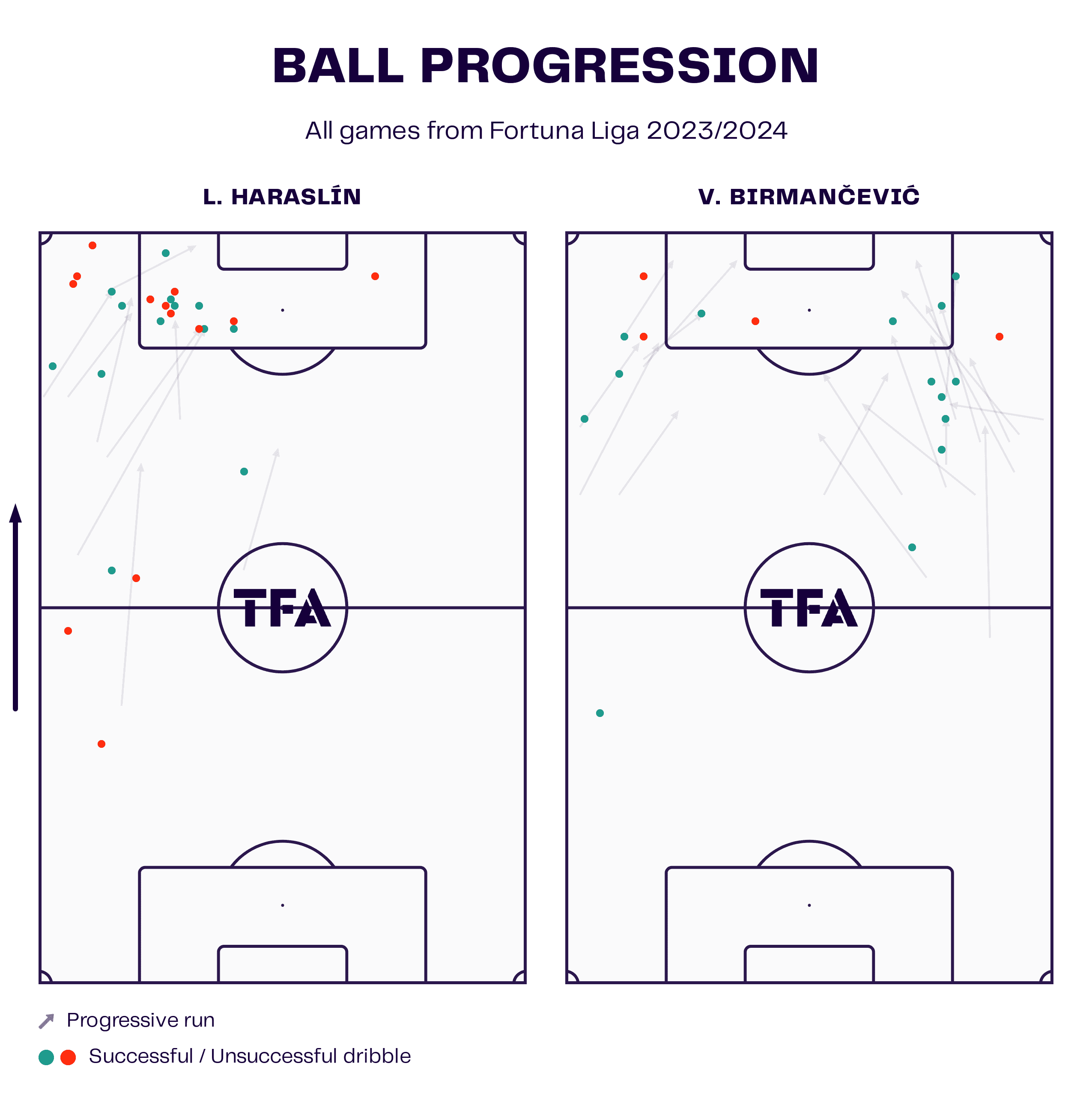
Both left-winger Lukáš Haraslín and right-winger Veljko Birmančević are in top form, with the former having scored one and assisted two last week versus Slovacko and the latter scoring two and assisting on in that same game.
Figure 7 is their respective ball progression maps from 2023/24, highlighting where their dribbles occur. Haraslín likes to attack the box from a wider angle, while Birmančević is happy getting more central, picking up the ball and driving at the defence from these positions.
Both will frequently roam about and often receive in the half-spaces as their team looks to progress from their own half, so these two will be key factors of Sparta’s play for Slavia to try and control on Sunday.
Contrary to Slavia, Sparta are actually overperforming their xG at this stage of the campaign. They’ve generated 17.27 non-penalty xG but converted 23 non-penalty goals. Still, their xG is vital — the second-highest in Czechia’s top-flight — and they are doing an excellent job of generating chances, though less than their city rivals.
However, that last point hasn’t mattered at this stage of the season, as they’ve been absolutely clinical in front of goal, particularly the aforementioned 27-year-old Haraslín, who’s scored six from 2.04 xG this term.
Birmančević, then, has been a critical creator for Sparta, generating the highest xA (1.9) of anyone from these two teams so far in 2023/24, so he’ll be an essential playmaker to pay attention to.
Sparta’s attackers have been enjoying their football this season, and that’s been rewarded in front of goal. They are in a moment of high confidence right now, and it may be an excellent time for them to take on their local foes with spirits so high.
The out-of-possession comparison
Slavia Prague’s out-of-possession play has probably been the most impressive aspect of the team’s overall performance this season. Trpišovský’s team have conceded just four goals and an xGA of 4.94 — the second-lowest in Czechia’s top-flight (no prizes for guessing who’s first — that would be Sparta Prague with 4.75 xGA).
The most impressive aspect of Slavia’s out-of-possession game is arguably not their ability to keep the opponent out. However, it’s their ability to quickly generate goalscoring chances after winning the ball.
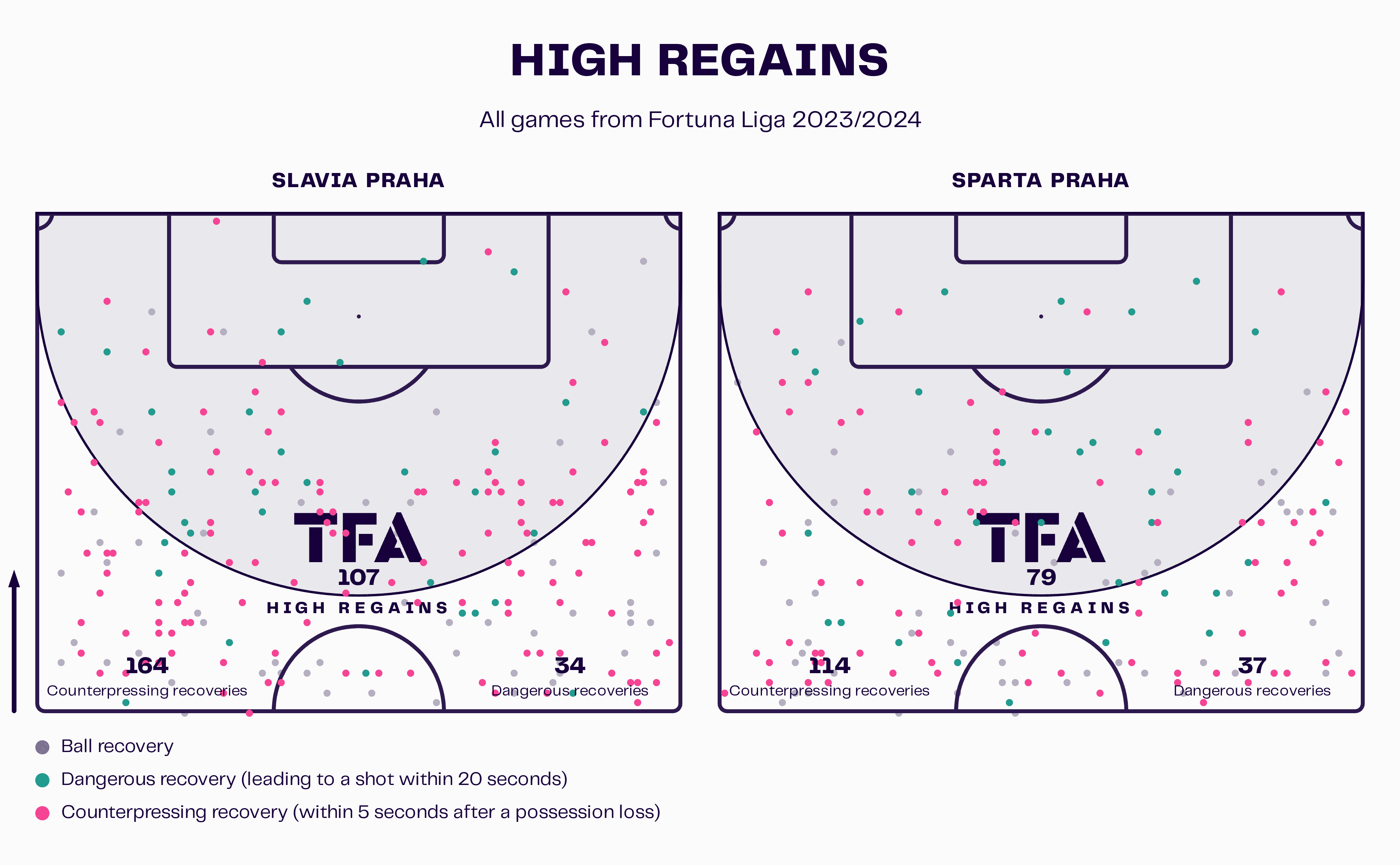
In Trpišovský’s case, his team’s press is their most outstanding playmaker. As figure 9 depicts, Slavia have been better at regaining the ball high than their city rivals have in 2023/24 thus far, making 107 high regains to their enemies’ 79.
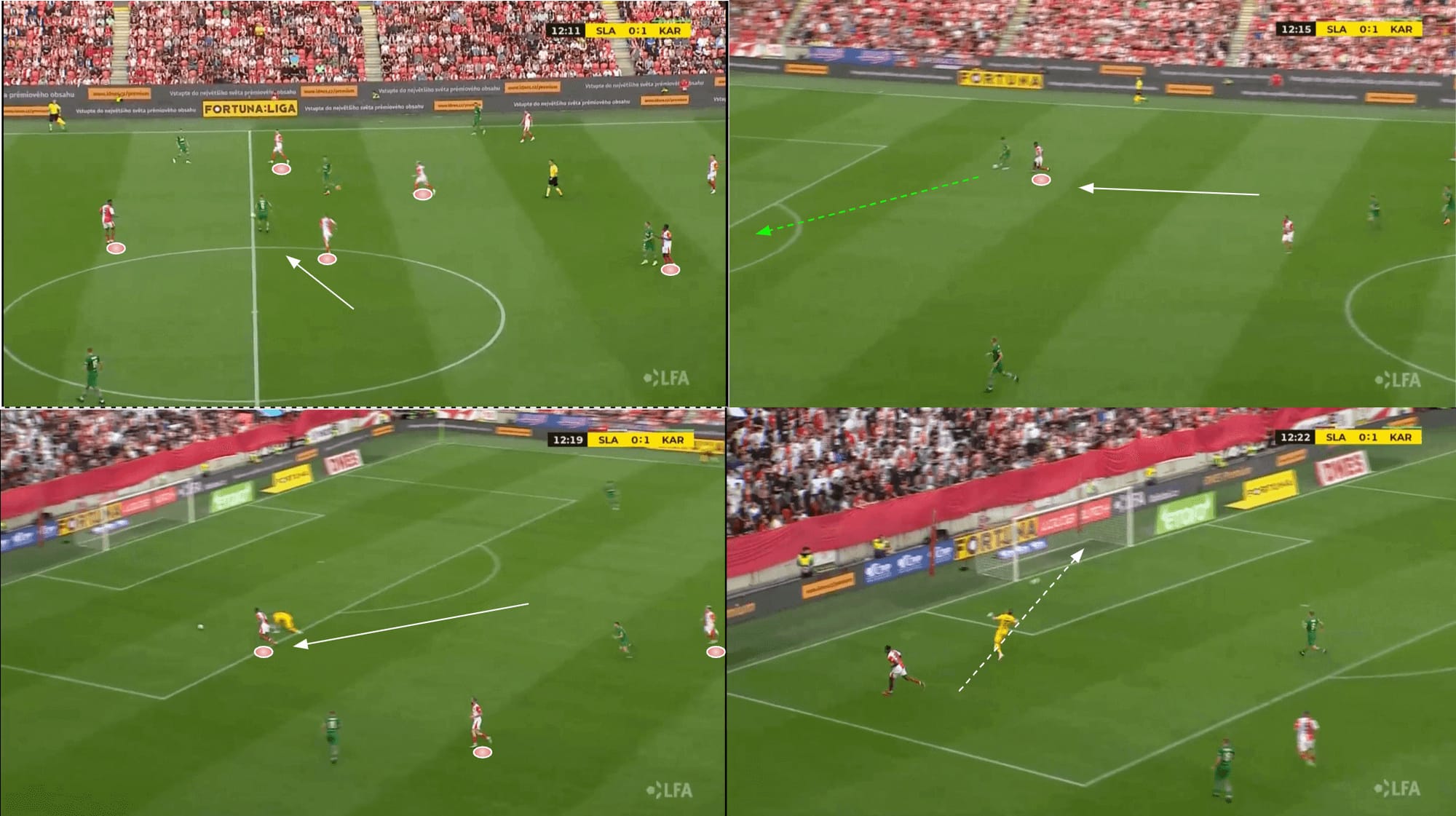
Slavia’s press has been incredibly aggressive this term, as you might surmise from the aforementioned numbers. This term, they’ve got a PPDA of 5.21 in the league — the lowest of any side in the Czech top tier.
We can catch a glimpse of how they operate without the ball in figure 10, here. In the top-left image, we see how their striker has cut the centre-back on the ball off from his centre-back partners while the wingers and central midfielders behind him focus on contesting the space and cutting off the near passing options.
Slavia’s goal here is to suffocate the ball carrier, give them no passing options, increase their time on the ball by making their decision very difficult and try to either get close enough to dispossess or force a wayward ball.
In this case, the centre-back escaped by playing the ball back to the goalkeeper. Still, Slavia maintained a high-intensity press, quickly creating a similar conundrum for the ‘keeper by congesting the space around him and blocking off the nearest passing options.
This time, Trpišovský’s side did buy enough time to dispossess the ball carrier — the ‘keeper — which generated a precious goalscoring opportunity which was taken. The critical aspects of Slavia’s press lie in their intent to congest the space and cut off the options around the ball carrier. This sees them give up space away from the ball, potentially making them vulnerable to a switch of play, while they bet on their ability to suffocate the ball carrier, as they showed here.
As figure 9 shows, our high regains image, Slavia, has been incredibly effective at counterpressing in 2023/24. This is where their playmaking without the ball really comes into play and combines with their direct approach on the ball; it’s why they keep so much possession despite taking such a straightforward approach. Even when dispossessed, they’re incredibly effective at immediately winning the ball back and pushing forward again, creating great goalscoring opportunities as a result.
Their forwards, midfielders and wing-backs are well drilled into the Trpišovský blueprint that he’s stamped on this club since 2017. They understand what’s expected of them; this consistency and familiarity across the board helps them.
The attitude to respond to losing the ball by immediately attempting to pressure the new ball carrier and win it back while pressing all the nearest passing options is paramount in Slavia’s transition to defence and their overall success. Without this aspect, their game plan is not as effective, so the players must carry out these roles diligently.
On the other side of things, though Sparta haven’t made as many high regains as Slavia have this term, they’ve still generated a lot of them. They’ve engineered more ‘dangerous recoveries’ than their city rivals, showing that the press is still an equally critical creator for them.
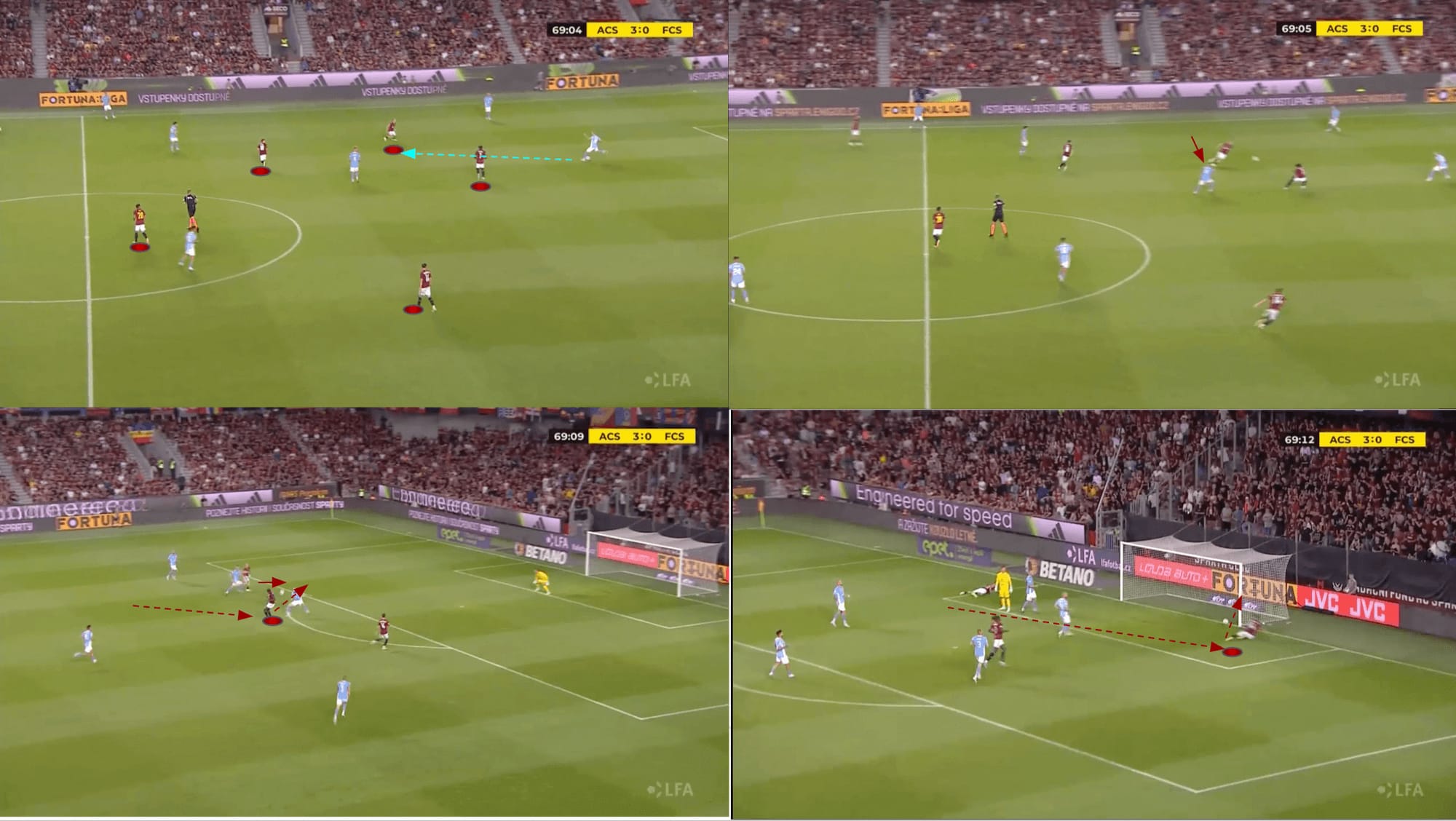
Figure 11 highlights Sparta’s 5-2-3 pressing structure. They’re disciplined and organised, typically sitting ever so slightly deeper than Slavia do but still in a mid-high block, challenging the opposition’s attempt to get moving forward from the backline.
They are typically more position-oriented than Slavia, who are more space-oriented in the press. We can see a free midfielder enticing this attempted line-breaking pass from the opponent’s centre-back here that allows Sparta’s left-winger to pull off the interception, drive forward, link up with the striker and get into the box, ultimately finding himself in a position to send the ball across goal into a teammate’s path.
Once inside the six-yard box, the receiver just has to tuck the ball away at the empty far post, which he does.
This was generated due to Sparta’s defensive organisation, emphasising how important this phase will be for them in their goalscoring attempts — not just their efforts to keep Slavia at bay.
Conclusion
There are a lot of critical battles here in respect of Sparta’s defence lining up against Slavia’s attack, but, again, Slavia are happy to go long and direct, which can negate Sparta’s press at times and put more of the onus on Sparta’s centre-backs to be organised and prepared to deal with the attackers as well as the direct play they’re faced with.
On the other hand, Sparta will try to be short with their build-up, creating an exciting dynamic versus Slavia’s highly aggressive defence.
This will be a highly entertaining tactical battle between two exciting coaches and two in-form sides that should make for some excellent Sunday viewing. Whoever comes out on top edges a significant psychological advantage in the Czech title race, though it is still very early in the 2023/24 season.





Comments